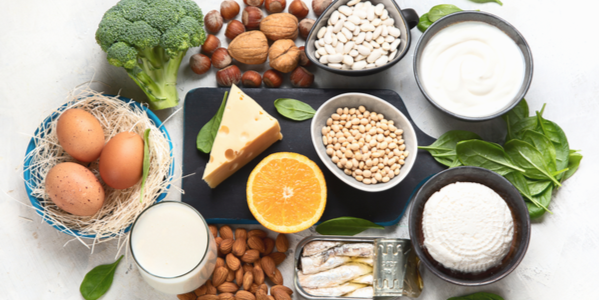
A few words are synonymous with calcium and typically include milk, cheese, yogurt and ice cream. While these are certainly potent sources of calcium, there are plenty of other calcium rich foods that can be included in a plant-based diet. Indeed, even vegan calcium sources exist, usually in the form of vegetables.
Let’s take a deep dive into what foods are high in calcium beyond the dairy aisle and end the adventure learning why calcium is vital for optimal health.
Calcium in Dairy
It’s widely accepted that dairy is the most potent source of calcium. Childhood nutrition taught in schools largely focuses on drinking milk to grow big bones and strong muscles. The old food pyramid emphasized dairy as a major food source and the newer MyPlate includes a blue circle to encourage a serving of dairy at every meal.
Dairy foods like milk, cheese, yogurt and butter are concentrated sources of calcium. However, they may not be the overall best sources for a variety of reasons such as the effects of dairy on digestive health. For instance, the way cattle and the like are raised and fed nowadays might impact the quality of the milk.
Thus, it’s wise to purchase high-quality sources of dairy such as grass-fed beef and butter and organic, unpasteurized milk from reputable sources if possible. Carefully produced raw or unpasteurized milk possesses numerous health benefits over the pasteurized forms sold in regular grocery stores. It is a health-supporting food with therapeutic potential and is more easily digested than the forms that have been processed.
Just like breastmilk, unpasteurized dairy milk is a living, whole food that provides plenty of calcium along with supportive enzymes and probiotics. In addition to calcium, raw milk is a potent source of vitamin A, D, and K, phosphorus, zinc, omega-3 fatty acids, and conjugated linoleic acid.
Conversely, the pasteurization of milk can reduce the bioavailability of calcium and phosphorous, vitamin A, B complexes, C and E. It may also reduce the presence of copper and iron, destroy the probiotic content, and inactivate beneficial enzymes like lactase and alkaline phosphatase. However, if the animals are not properly raised, then pasteurization of milk is necessary to kill pathogens.
If the milk industry appears controversial, that’s because it is. Especially as the rise of lactose intolerance from dairy products permeates and interest in plant-based diets rises, identifying other sources of the mineral calcium is vital.
Dairy-Free Calcium Sources
Beyond dairy, the main foods rich in calcium include seafood, leafy greens, legumes, dried fruit, tofu, and fortified foods.
Nonetheless, here are dairy-free foods denoted in milligrams (mg) of calcium.
Vegetables High In Calcium:
• Cooked collard greens: 266 mg
• Cooked kale: 180 mg
• Soybeans: 175 mg
• Baked beans: 160 mg
• Cooked bok choy: 160 mg
• Cooked broccoli: 100 mg
Protein High In Calcium:
• Canned sardines: 325 mg
• Tofu: 205 mg
• Canned salmon: 180 mg
• Shrimp: 125 mg
Other Foods High In Calcium:
• Fortified oatmeal: 140 mg
• Fortified cereal: 100-1000 mg
• Figs: 65 mg
• Oranges: 55 mg
• Fortified plant milks: 100-300 mg
• Fortified orange juice: 350-500 mg
The Critical Roles of Calcium
What’s all the fuss about calcium anyways? Calcium is the most abundant mineral in the human body, in front of sodium, potassium, magnesium, and phosphorus.
The mineral is largely stored in the bones and teeth but also found in nerves, blood, and other body fluids. It plays a role in bone and heart health, nerve signaling, and muscle contraction among other minor roles. However, it’s most well known for helping to prevent osteoporosis, a condition characterized by brittle bones.
Overall, calcium helps the body to:
• Build strong bones and teeth
• Help blood clot
• Send and receive nerve signals
• Contract and relax muscles
• Release hormones and other chemicals
• Maintain a normal heartbeat
Daily calcium recommendations vary by age and sex based on different needs throughout life. Adolescents aged 9-18, adults aged 50-70, and pregnant and breastfeeding women have the highest requirements around 1200-1300 mg per day. For all other populations, 1000 mg is the standard recommendation.
If unable to obtain sufficient calcium from food sources, a supplement is encouraged. An upper limit of 2500-3000 mg per day exists, so finding a supplement within the 1000-2000 range is usually adequate to maintain healthy levels.
Furthermore, vitamin D greatly enhances the absorption of calcium, so finding a supplement with both calcium and vitamin D and/or consuming foods high in vitamin D along with calcium support overall calcium status best.
In Summary
Calcium is typically synonymous with dairy foods, but many others including collard greens, kale, and canned sardines contain equivalent amounts of calcium or higher. Important for teeth and bone health, the nervous system, and muscle contractions, it’s necessary to maintain sufficient levels of calcium throughout life.
Finally, it may be smart to include dairy-free calcium sources for various reasons. This especially includes those who follow a dairy-free or vegan diet.
References:
A Guide to Calcium-Rich Foods. National Osteoporosis Foundation. Published May 20, 2020. www.nof.org/patients/treatment/calciumvitamin-d/a-guide-to-calcium-rich-foods/.
Jennings KA. Top 15 Calcium-Rich Foods (Many Are Non-Dairy). Healthline. Published July 27, 2018. www.healthline.com/nutrition/15-calcium-rich-foods.
Smith S. Letter to Medical Professionals about Raw Milk. Raw Milk Institute. Published April 9, 2020. www.rawmilkinstitute.org/updates/letter-to-medical-professionals-about-raw-milk.
Wax E. Calcium in DIET: MedlinePlus Medical Encyclopedia. Published February 2, 2019. medlineplus.gov/ency/article/002412.htm.







